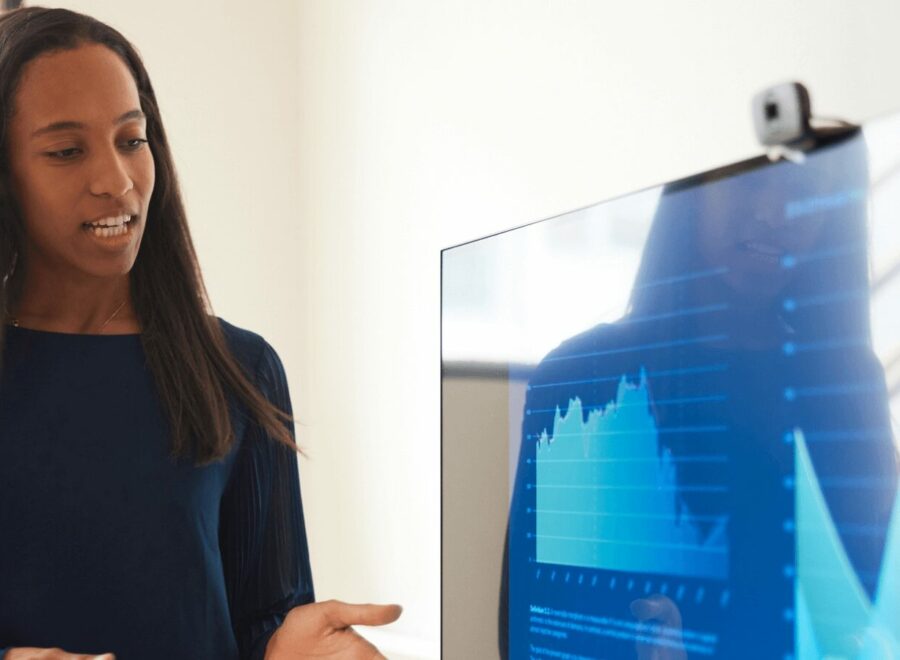Growth was stalling and churn rising. The answer came from a place DISH’s leaders almost overlooked.
A cold wind blew across the fallow Indiana cornfields as the small group of execs stood in the hotel parking lot. Spring would be late this year. The execs were a long way from their home base in Denver. They were marketers and technologists for DISH Network, one of the fastest-growing satellite TV services in the country. More than a few of them looked out of their element. But they were here following a hunch.
Their leader was Patti Fries, DISH Network’s head of customer insights. Patti had convinced them to make the trip out to Indiana in search of their next big growth market. But this place didn’t look like Chicago or LA. The cars driving by were old. The houses were few and far between. Staring out at the barren fields, more than one exec wondered if this wasn’t a mistake. Patti smiled. She knew they were onto something.
A Hidden Problem
When Patti first joined DISH Network in 2011, it had never had an insights leader. She had no team, no budget, and no real champion. Her first day on the job, she learned that the CMO who hired her had quit the day before. This was going to be interesting. If she was going to succeed, Patti needed to start adding value quickly.
Patti set up one-on-one meetings with senior leaders to figure out what was keeping them up at night. She immersed herself in the company’s financials. And she dug into existing subscriber data.
That’s when she found the problem.
DISH had been going like gangbusters in the early 2000s, amassing 14 million subscribers by 2010, closing in on DirecTV, the market leader. But by 2011, the emerging “cord-cutting” trend and intensifying competition had slowed the juggernaut, and subscriber growth was coming at an increasing cost.
In its race to be Number One, DISH had drunk the Silicon Valley Kool-Aid that says winners are those who grow their user base the fastest—profitability be damned. DISH was attracting customers through irresistible promotions like a $19.99 a month subscription, free installation, and two months of free service.
The problem was with the free installation. Setting up DISH’s TV service required a new satellite dish. It required the company to send a technician out to customers’ homes. And it required that technician to spend time climbing on a roof, wiring up the dish, and activating the service. All of that took time. On a good day, a technician could install four or five dishes. It also took money. Each installation could cost over three hundred dollars. With a $19.99 subscription, DISH wouldn’t see a profit for at least three and a half years.
Of course, that’s only if the subscriber stayed, which they didn’t.
Most subscribers had two-year contracts. At the end of those two years, many would jump to a better deal offered by DirecTV or a cable company. Some would even try and renege at the end of their two-month free trial. The problem wasn’t growth—it was churn. DISH Network’s profitability was getting erased by switchers and deal-seekers. And the more DISH grew, the bigger the problem got.
Patti stared at the data in disbelief. DISH Network’s execs were some of the smartest people in the industry. How could this be happening? The problem was one of incentives. In its drive to grow, DISH had built its bonus structure around new subscribers, not net new subscribers. Retention was someone else’s problem. As long as the top-line numbers looked good, no one was asking questions about the underlying financials. Sharing her discovery with management, the team realized they needed to do something fast.
But Patti also discovered something else in the subscriber data: a group of users with unusually high retention rates. These people signed up for DISH and then stayed with the company for years. They weren’t quick to hop to another company just to chase a better deal. Many of them were older than DISH’s ideal demographic. And they lived in places that were far outside of the urban and suburban markets that DISH had been focusing on. Places like rural Indiana. If these folks were the answer to DISH Network’s churn problem, Patti needed to find out why.
Time in the Heartland
Patti knew that focus groups and surveys wouldn’t get her the answer. She needed to get below the surface. Beyond the audience data and product surveys. Working with Jump, she put together a program of deep ethnographic research, where they could get beyond interviews.
Over the course of several weeks, the team immersed itself in small-town life. They ate apple pie in local cafés. They attended high school basketball games. They went to chili fundraisers and chamber of commerce meetings. They visited dairy farms and attended church services. Most importantly, they built relationships and listened to the stories of what mattered to people in the Heartland.
What they found was why DISH mattered. For folks in rural markets, satellite TV was more than just entertainment—it was a vital connection to the outside world. Many subscribers lived in places that were too remote to get broadband or even cellphone coverage. Yet, those people needed to know what was going on. Farmers would get up in the morning and turn on the television. RFD-TV, the rural news channel, would tell them what the crop prices were today. Then they’d switch over to The Weather Channel to find out if there was a storm blowing in. Based on what they heard, folks would then plan their day. Television was their Outlook calendar.
Customers in the Heartland also thought differently about what they bought. These folks weren’t obsessed with upgrading to the latest greatest gadget. For them, something you bought was something you held onto and used for a long time, whether it was a car, a drill, or a satellite dish. Many of them drove old cars, not because they couldn’t afford a new one but because getting a new one would be wasteful. People took a lot of pride in getting the “fullest use” out of what they had.
For these people, price was nowhere near as crucial as it was for DISH’s other customers. When rural customers were asked what would motivate them to switch or stay, price ranked 17th on the list. What people really wanted was trust and reliability.
The Big Bet
Flying back to Denver, though, all of this seemed to senior execs like a huge leap. After all, high-growth tech companies don’t go chasing farmers in Indiana—they go after early adopters in places like Seattle and San Francisco.
Focusing on rural customers would also force DISH to completely revamp how it goes to market. In its quest to win over users, DISH had been focused on a “more-is-better” marketing message, touting the latest technical capabilities of its equipment, like the ability to record 2,000 hours of programming and four shows simultaneously. But rural residents didn’t care about cool features. They were interested in a service that would be reliable and good value. Something that helped them spend more time with their families. Something that reflected their values.
From the perspective of customer acquisition, the new plan looked lousy on paper. DISH might be making a bad problem even worse. If installation costs were high in the city, they were astronomical in the country. In a metropolitan area, a technician could complete five installations in a day. In a rural market, they’d be lucky to finish two. With many rural customers, DISH’s break-even could go from three years to even five. Would farmers stick around that long? There was no way of knowing.
At that point, Patti had to move past the data and rely on something else: her gut. Fortunately, her life experience had given her gut a lot to rely on. Even though Patti lived in Denver, she wasn’t originally from the suburbs. She had grown up in Wahoo, Nebraska, population 3,517. She had known these people most of her life. And while the DISH team was conducting its insights work, something powerful was opening up inside her. Something that connected her back to her roots. For Patti, every ethnographic interview and every town visit was more than a research activity. It was a homecoming. It was a remembrance of what really mattered.
The idea of sticking with something was more than a value proposition. For folks in the Heartland, buying a product—or a satellite service—was entering into a relationship. And if you were treated right, you’d hold onto that relationship for years to come. It was about loyalty. And it was about respect. Subscribers in the Heartland were a thousand miles from suburban switchers and deal seekers, not only physically but spiritually. That idea of respect mattered to them. And it mattered to Patti.
Subscriber churn continued to grow in the suburbs, and DISH Network’s leadership was forced to move forward with an outreach to rural markets. The initial numbers were promising. New customers began to sign up quickly. The old ones stayed.
Patti was put in charge of a marketing unit focused on rural consumers. She reoriented DISH’s messaging to emphasize values like reliability and simplicity, not technological prowess. Getting a satellite dish would do more than allow you to record hours and hours of programming. It would allow you to put off upgrading to a smart TV and get a few more years of life out of your existing television set. To get the fullest use.
Patti partnered with country music stars Clint Black and Dierks Bentley. She helped DISH sponsor a country music festival in small-town Buena Vista, Colorado. Dierks Bentley’s song “I Hold On” became something of a rallying cry…
“It’s just an old beat-up truck.
Some say I should trade up now that I got some jangle in my pocket.
But what they don’t understand
Is it’s the miles that make a man.
I wouldn’t trade that thing in for a rocket.”
Within a few years, DISH had successfully pivoted to make rural America a central part of its growth strategy. In 2007, rural subscribers made up nearly 40% of DISH Network’s customers. By 2021, they accounted for nearly 70% of new subscribers. Customer churn plunged to less than 2 percent. The financials improved.
As the years went by, satellite TV providers have been challenged by the rise of broadband alternatives. DISH Network’s rural business has remained a critical bulwark for the business. People are getting the fullest use out of their service.
Insights over Risk Taking
Future-focused leaders seem to take big bets all the time. But when you look closer, they aren’t big bets at all. They’re decisions based on insights, not risk-taking. They’re decisions that are grounded in data, buoyed by intuition and real-world experience. Patti Fries made a move that seemed like a risk. But from her perspective, it wasn’t a risk at all. It was the right thing to do.
As the world gets weirder and traditional business playbooks break down, leaders need to keep asking this fundamental question: What do we know that no one else knows? Are we digging into the data? And are we connecting that data to real-world experience?
The best insights are still fundamentally human. They come from getting out into the world and seeing what other people are missing. You might come back with a discovery of something new, something that can show you a new way to win. You might even come back with something more important: a reminder of what really matters in your life.

 Dev Patnaik
Dev Patnaik


